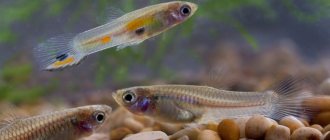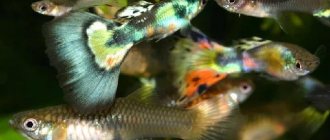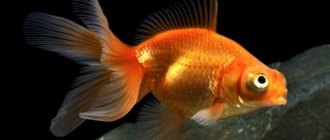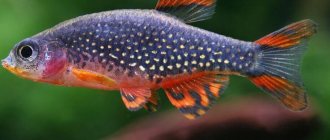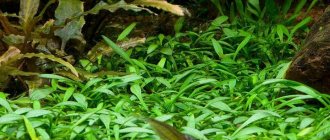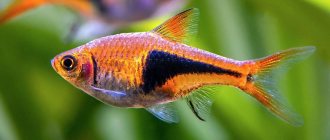Author: Krait
06 October 2021 17:58
Tags: aquariums animals fish facts
3674
11
In any pet store or market you can see small fish with large tails and bright colors. This guppy is the most common and popular aquarium fish.
1
See all photos in the gallery
Guppies!
0
×
0
For many amateur aquarists, this hobby began with her, and experienced aquarists sometimes do not forget about guppies. This is a favorite subject for the study of genetics. The discussion above was about males; they are distinguished by large tails and bright, varied colors. Their sizes are small: 1.5 -3 centimeters. Females are much larger, up to 6 centimeters, but inconspicuous. The color is grayish, there are no large tails. Although in aquariums there are partially colored females with enlarged caudal fins. Various color options and body shapes can be seen in the photo on the left.
Habits of fish knife
It would seem that the absence of a dorsal fin negatively affects the mobility of Apteronotus, but this is far from the case. Fish can move
- up and down,
- forward,
- backwards,
- turn over belly up
- hang in one place.
And she performs all these dexterous movements only thanks to her long lower fin and an almost inflexible body!
And the speed of movement in water can be more than 0.1 m per second. It seems that the fish is piercing the water column. A real river hunter!
VIDEO - BLACK KNIFE FISH
TETRAS CONTENTS TYPES OF SPAWNING PHOTO COMPATIBILITY VIDEO.
Guppies are ideal if your child asks for an aquarium. Guppy - red flamingo
0
The small size of the fish will allow you to keep 5 - 7 pieces in a 15 - 30 liter aquarium installed on a desk. If there is a low density of fish and the presence of undemanding living plants, you can refuse to filter and aerate the water. The main thing is not to forget, in this case, to change the water more often and clean the soil.
Of course, additional lighting is needed, but a table lamp is quite suitable as it in the evening. You can feed dry or industrial food from a jar. The fish can easily endure a week-long hunger strike in your absence, and there is no need to ask their neighbors to feed them; accidental overfeeding, with the best intentions, can lead to water damage and death of the fish. As you can see, the costs of time and finances in this case are not great. Currently, guppy fish are distributed in nature in most warm-water fresh water bodies. They spread artificially in order to fight the malaria mosquito, as they happily eat their larvae. Initially they existed in Brazil, Venezuela and Guiana. There are local populations even in Russia, in places where warm runoff is discharged. They were apparently started by aquarists who released fish there.
Description
Aquarium fish knife is a weakly electric type. In reservoirs they live in turbid bottom waters, so they have learned to navigate in space by emitting impulses with an electric organ. The electric feature of the fish knife compensates for poor vision. The knife fish is a non-aggressive species, therefore it does not use its electrical ability for battles, but only for orientation, in extreme cases, for the purpose of defense against predators and representatives of its species.
Dimensions in nature reach 50–55 cm. In aquarium conditions, body size is 30–35 cm.
Appearance
Black knife is a black fish with two white stripes - one near the caudal peduncle, the second near the caudal fin. Has no scales. The body of the fish is flattened, long, and reaches quite large sizes. The dorsal and ventral fins are missing. They move using the anal fin. This fin extends from head to tail.
Behavior
The black knife fish is not a very active species. It will be stressful to be around active species. Leads a secretive lifestyle, hiding in algae and driftwood during the daytime. Shows activity only at night.
Although the body of the fish is not very flexible, thanks to its long anal fin, it is capable of performing various dexterous movements. For example, they have the habit of turning over with their stomach up, freezing without moving, and moving backwards.
Hunting habits
These fish are predators that hunt at night. They use their color as camouflage. They feed on small species of fish, insects and their larvae. Consider the carnivorous nature of the fish when choosing neighbors.
Lifespan
The black knife lives up to 12–15 years, in the wild up to 10 years.
Male guppy
0
A huge number of guppies are bred in aquariums, differing in color, shape of fins and tail. The starting material was taken from various natural reservoirs. As a rule, therefore, it is almost impossible to systematize them. There are many variations of the tail fin: round tail fin, two swords, top and bottom, one sword, radish, lyre. The upper fin can be a scarf, even descending to the caudal fin. Monochrome colors are spectacular: completely black - black prince, red - albino red, green-malachite - Moscow malachite, blue - Moscow blue. Beautiful marbled guppies have tails painted black and white or black and yellow with small spots. In different countries there are a huge number of associations of guppy lovers who are passionate about the selection of these wonderful fish. The largest is the International Guppy Breeding Council, which unites 12 Western European countries. He has developed the most detailed selection standards and annually holds international competitions and exhibitions.
Diseases
The most common disease of black prince fish is ichthyophthyriosis or white spot disease. It occurs due to the absence of scales on the body. Ichthyophthyriosis is caused by parasitic ciliated ciliates.
Symptoms of the disease:
- The appearance of small tubercles.
- The anal fin loses its beauty and becomes frayed and stuck together.
- The fish moves slowly.
- The fish's body is swollen.
To select a drug for treatment, consult your veterinarian.
A more rare disease is acidosis, which occurs due to low acidity of water. The fish are slow, lethargic, and white spots appear on the body. Acidity is increased by baking soda.
Guppy - maintenance and care
0
Guppies are quite unpretentious, and keeping stray fish is not difficult at all. They are not picky about the composition of water and the quality of feed. But if you want to have purebred males with large fins and tails, then the conditions for them must be ideal. The most suitable water hardness is 6-10°. The optimal temperature is 24°C, although the range in which these fish can live is quite large: 18-30°C. It is advisable to change a third of the water once a week to settled water at the same temperature. It is useful to add table salt at the rate of a teaspoon per 10 liters of water. Despite the fact that a pair of adult fish can live even in a three-liter jar, to keep elite guppy fish, aquariums from 50 liters are used at the rate of 1 liter of water per male and 2 liters per female, with intensive aeration and water filtration.
Male guppies can bully each other when fighting for a female, but usually such clashes do not lead to serious injuries. But when kept with other species there may be problems. These fish themselves are small and harmless. And therefore they may suffer from other, larger and more nimble neighbors. This is especially true for males with huge tails. They can only be kept together with peace-loving small species. Even small barbs are already causing problems. Given the variety of shapes and colors of this common fish, it is best to keep it in a species aquarium.
Feeding
Guppies can be fed both plant and animal foods. It is important that the diet is properly balanced. The guppies themselves can eat some algae that is in the aquarium. The diet of black guppies should include:
- Cyclops;
- rotifers;
- daphnia;
- mosquito larvae;
- bloodworm;
- spirulina, etc.
You can also feed guppies with dry food, but only high quality food. Abuse of them is strictly prohibited. It is enough to feed adult guppies 1-2 times a day.
These fish have a tendency to become obese and should not be overfed. Otherwise, guppies lose their ability to reproduce and begin to get sick often. Adult fish need fasting days (no food is given at all), which can be done once every 7-10 days.
Female guppy with colored tail and upper fin
0
To obtain intense coloration of males, lighting is essential. You need not only long-term additional lighting, but also the presence of natural sunlight in the morning or evening. These fish in a home aquarium evenly inhabit all layers of water. Feeding guppies is quite simple. They are always hungry and ready to eat any type of food. But if you use a variety of high-quality live food and specialized commercial food, this will increase their growth rate and brightness of color. These fish do not live long in aquariums, for several years. The lifetime is highly dependent on temperature. The higher the temperature, the faster the metabolic processes and the shorter the lifespan of the fish. The aquarium must have thickets of plants and free space for swimming. Plants serve as a shelter for females from overly annoying males. And in the case of breeding in a community aquarium, it serves as a refuge for the fry. Guppies require plant feeding, so they happily pluck algae from plants and stones.
Reviews
Aquarists like to keep these black pets in the aquarium, they add elegance and beauty to the aquarium. But some note that caring for them is somewhat difficult, especially when breeding. And also some breeders are not happy that the pet is constantly out of sight, often hiding, and you can only enjoy its beauty temporarily.
Guppy - reproduction and breeding
Breeding guppy fish is extremely simple; they reproduce independently in a community aquarium without any additional conditions. In this case, there may not be a male for a long time, since females can bear offspring many times after one fertilization. You can buy one adult female at a pet store and she will produce offspring for you up to 8 times. As everyone knows, guppies are viviparous. Instead of caviar, they spawn fully formed fry that are swimming and ready to feed immediately. The eggs develop inside the mother and she lays the fry already fully formed, like miniature copies of their parents. Fertilization occurs in the mother's body with the help of a special organ of the male - the gonopodium, which is formed from the anal fin.
Compatibility
Black guppies are peaceful and calm; they can easily be kept in the same aquarium with non-aggressive fish. Excellent neighbors are:
- tetras;
- neons;
- zebrafish;
- rasboras;
- mollies.
Guppies get along well with Ancistrus and Corydoras. Compatibility with iris and bright barbs is acceptable, but such neighbors can bite the males’ beautiful fins.
Do not place guppies with fish that can fit into their mouths. Otherwise, one day one of the inhabitants of the aquarium will simply eat them.
If you do not plan to breed black guppies, representatives of different species and colors can be placed in one aquarium at the same time. In this case, the color of the offspring will be very variegated and multi-colored.
The Black Prince is a bright representative of aquarium fish. They are unpretentious, keeping such pets usually does not cause any difficulties. They are not picky in their diet and do not require special conditions for reproduction. The main thing is to make sure that in the same aquarium there are peace-loving fish that will not attack each other.
Malek guppy
0
“Pregnancy” of females lasts 35-45 days, depending on the water temperature. The number of fry in females varies. It depends on her age, size and feeding. For the first time, females spawn about a dozen fry, and the old ones spawn up to a hundred. These fish are “bad” parents; they will readily eat their own young if they are hungry. Therefore, if you are planning to produce offspring, the female must be placed in a separate special vessel with a large number of small-leaved plants before giving birth.
A few days before giving birth, the female’s abdomen increases greatly and takes on a square shape. As soon as the fry are swept out, it must be removed. In a well-balanced aquarium, many guppy fry will survive unattended, hidden in dense vegetation, and once they grow up, they will be safe, but due to the lack of food in the general aquarium, the fish will have small fins and dull colors.
When large adult males with large fins and tails are used for breeding, problems with fertilization may occur due to their slow movements. In this case, it is better to use young males, who are more nimble, or place the desired pair in a separate small aquarium. In a community aquarium, young males always have an advantage when mating.
To feed guppy fry, you can use any food of suitable size. Considering that the fry are born large, there are no problems. To obtain high-quality specimens, the food must be varied, and the nursery aquarium must be kept clean and some of the water must be changed periodically.
Fish gutting knife: what you need to know when choosing one for fishing
For gutting fish while fishing, a knife with the following characteristics is suitable:
- the blade is narrow and moderately flexible, ranging from 150-250 mm long;
- There should be no notches on the blade, but it is highly desirable that there are grooves on the blade (on its side parts);
- Stainless and high-carbon steel is used in production;
- the handle should not be slippery; it is better if it is made of impregnated wood or rubber-coated plastic.
Knife for cleaning fish from scales You need to purchase a knife for cleaning fish from scales separately, and it is better if it is equipped with a container.
Some models of such tools have removable containers, which makes it possible to use them both for cleaning scales and for further cutting the product. When choosing a knife for gutting fish, you should also take into account what kind of fish you are going to cut. For example, for large carcasses, a tool with serrations and serrated sharpening is suitable, but for sea fish it is better to use knives with indentations on the surface - this will prevent sticking of dense flesh.
Which one is suitable for frozen?
Frozen fish most often goes on sale; to cut it, it is better to use a cleaver or a knife-saw. These tools are great for working with large carcasses, but will not allow you to separate the flesh from the bones and skin. True, there are miniature cleavers on the market with a sharp cutting edge, and if you have the skill, you can even cut fish with high quality, right down to obtaining slices.
If you need to cut frozen fish into thin slices, it will be difficult without a professional slicer. The only option is to wait for the pulp to defrost and use a classic fillet knife.
Which one is needed for cutting pieces
A knife with a long, thin/narrow and curved blade is not suitable for cutting pieces - it will break or “tear” the flesh, making the pieces sloppy. To achieve the desired result, it is better to use a regular kitchen knife with a blade sharpened to 15 degrees, which will allow you to cut both large bones of the spine and small rib bones.
Kitchen knife for cutting fish
Cutting pieces of large carcass will be as convenient and quick as possible when using a cleaver/hatchet. You can use a meat cleaver.
How to make it yourself: tools
You can make a fish cutting knife with your own hands if you have the following tools and materials:
- old hacksaw and epoxy glue;
- a fragment of a board and steel tubes for making pins;
- clamps and orbital sander;
- “grinder”, hammer and jigsaw;
- clamps, vice and drilling machine;
- planer and belt sander;
- devices for sharpening knives;
- ruler, marker.
Step-by-step instruction
Algorithm for making a fish fillet knife yourself:
- Separate the blade from the old hacksaw. Using a marker, draw a drawing of the future knife on a metal surface. One hacksaw blade can produce several cutting knives, but of different lengths.
- Clamp the workpiece in a vice and use a grinder to cut the blade according to the drawing. You cannot cut exactly along the marker line; you should step back a little. When working with a grinder, you need to periodically stop and pour water on the workpiece and cool it - overheating provokes a deterioration in the quality characteristics of the metal.
- Perform sanding work using a belt sander. If there is none, then you can clamp the workpiece in a vice and do the work manually using sandpaper of different abrasiveness. At the same stage, a shank is formed, which will serve as a handle.
- Cut out the pins that will attach/fix the linings on the handles and can act as decoration for the product. For their manufacture, copper or brass tubes are used; it is important to avoid the use of steel that is subject to corrosion. The tubes must be cut to a certain length, which corresponds to the distance between the pads on the future handle.
- Drill holes for the pins. This is done with a drill at low speeds; you need to periodically interrupt the process and cool the metal.
- Make wooden overlays. You can use thick rubber or plastic, but in any case you need to make holes in them in exact accordance with those already made in the metal shank.
- Assemble the handle by first gluing the pads together with epoxy glue and only then secure them with pins.
- Make the blade as thin as possible, for which you should use an original grinding machine. You can limit yourself to sandpaper, first securing it to a wooden block. Grinding should be carried out evenly on both sides of the blade, otherwise it will simply warp.
The final stages are sharpening and polishing the blade and treating the wooden handle with special liquids that prevent it from slipping in the palm and absorbing odors and moisture.
Watch the video on how to make a fish knife from a saw:
Since a homemade knife for cutting fish is not subjected to heat treatment, its blade will need frequent editing and sharpening.
Colors
Cobra guppies come in several colors. Let's look at the most popular varieties among aquarium fish lovers.
- Blue cobra - this fish can easily be considered one of the most beloved fish among aquarists. In the natural environment, its relatives lived in small rivers flowing in South America. They had a beautiful red color, so biologists took them as the basis for breeding cobra guppies. Males have a dark blue body with a yellow-orange pattern. A similar pattern is also noticeable on the fins and in the tail of the fish, making the pets look especially decorative and impressive.
Males are usually smaller than females, and the latter, in turn, are more faded, only the tail plumage has the same bright and rich shade as that of males.
- Red cobra - in science, this fish is known as filigree. It is distinguished by bright red fins, the body is much paler, but also has a pinkish-scarlet tint. Like other cobras, the filigree has an iridescent pattern that gives the scales a snakeskin appearance.
- The Yellow-Golden Cobra is a breed of Asian origin, characterized by a yellowish tint with a characteristic metallic bluish sheen. At the same time, the “serpentineness” manifests itself very clearly. The caudal fin has a fine pattern, and the elements of the pattern on it are small and separated from each other. In general, the pattern of the body is formed by a process in the upper part, colored reddish - it is directed from the top to the dorsal fin.
- Green cobra - as the name suggests, the color of this fish is dominated by green shades, the tail fin resembles a skirt with a slightly concave rear part, the bottom edge is slightly rounded. The round-shaped spots are arranged in a random order and cover the entire body of the guppy, giving a distinct resemblance to a reptile.
Other types
- Sunset. The color is dominated by the colors characteristic of the evening sky: yellow and red.
- Galaxy is a fish with a scattering of black dots on a multi-colored background.
- Martin. The guppy's tail has elongated rays, which makes it look “ragged.”
- Red multicolor carnation. Variegated plumage of a brick shade with a black pattern.
- Berlin. The guppy's fins are scarlet, and the body has orange, silver and gray tones.
